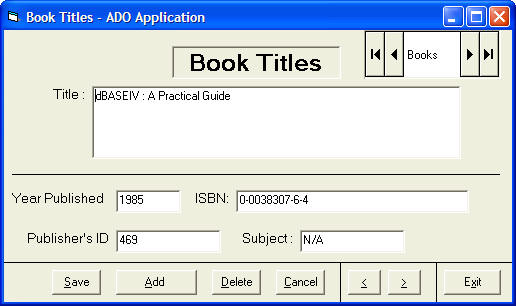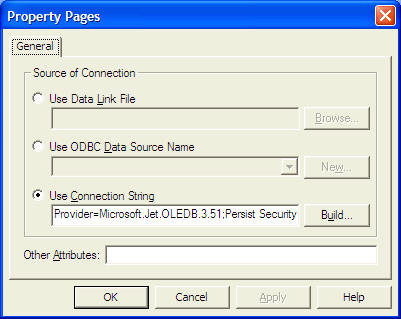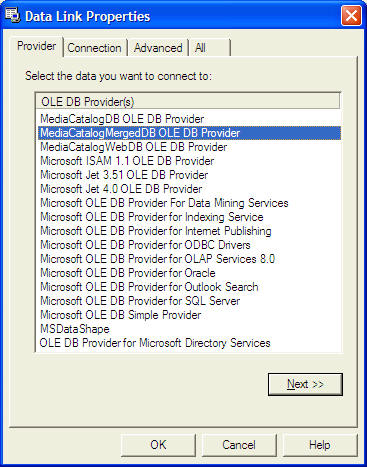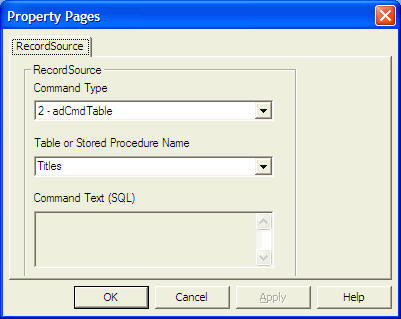
Figure 25.1: The Runtime Interface
The property settings of all the controls are listed as in Table 25.1 below:
Table 25.1: Property Settings
| Control Property | Setting |
|---|---|
| Form Name | frmBookTitle |
| Form Caption | Book Titles -ADOApplication |
| ADO Name | adoBooks |
| Label1 Name | lblApp |
| Label1 Caption | Book Titles |
| Label 2 Name | lblTitle |
| Label2 Caption | Title : |
| Label3 Name | lblYear |
| Label3 Caption | Year Published: |
| Label4 Name | lblISBN |
| Label4 Caption | ISBN: |
| Labe5 Name | lblPubID |
| Label5 Caption | Publisher's ID: |
| Label6 Name | lblSubject |
| Label6 Caption | Subject : |
| TextBox1 Name | txtitle |
| TextBox1 DataField | Title |
| TextBox1 DataSource | adoBooks |
| TextBox2 Name | txtPub |
| TextBox2 DataField | Year Published |
| TextBox2 DataSource | adoBooks |
| TextBox3 Name | txtISBN |
| TextBox3 DataField | ISBN |
| TextBox3 DataSource | adoBooks |
| TextBox4 Name | txtPubID |
| TextBox4 DataField | PubID |
| TextBox4 DataSource | adoBooks |
| TextBox5 Name | txtSubject |
| TextBox5 DataField | Subject |
| TextBox5 DataSource | adoBooks |
| Command Button1 Name | cmdSave |
| Command Button1 Caption | &Save |
| Command Button2 Name | cmdAdd |
| Command Button2 Caption | &Add |
| Command Button3 Name | cmdDelete |
| Command Button3 Caption | &Delete |
| Command Button4 Name | cmdCancel |
| Command Button4 Caption | &Cancel |
| Command Button5 Name | cmdPrev |
| Command Button5 Caption | &< |
| Command Button6 Name | cmdNext |
| Command Button6 Caption | &> |
| Command Button7 Name | cmdExit |
| Command Button7 Caption | E&xit |
To be able to access and manage a database, you need to connect the ADO data control to a database file. We are going to useBIBLIO.MDB that comes with VB6. To connect ADO to this database file , follow the steps below:
a) Click on the ADO control on the form and open up the properties window.
b) Click on the ConnectionString property, the Property Pages dialog box will appear, as shown in Figure 25.2.

Figure 25.2: Property Pages
When the dialog box appear, select the Use Connection String's Option. Next, click build and at the Data Link dialog box, double-Click the option labeled Microsoft Jet 3.51 OLE DB provider.

Figure 25.3: Data Link Properties
After that, click the Next button to select the file BIBLO.MDB. You can click on Text Connection to ensure proper connection of the database file. Click OK to finish the connection.
Finally, click on the RecordSource property and set the command type to adCmd Table and Table name to Titles. Now you are ready to use the database file.

Figure 25.4
Now, you need to write code for all the command buttons. After which, you can make the ADO control invisible.
For the Save button, the program codes are as follow:
Private Sub cmdSave_Click()adoBooks.Recordset.Fields("Title") = txtTitle.Text
adoBooks.Recordset.Fields("Year Published") = txtPub.Text
adoBooks.Recordset.Fields("ISBN") = txtISBN.Text
adoBooks.Recordset.Fields("PubID") = txtPubID.Text
adoBooks.Recordset.Fields("Subject") = txtSubject.Text
adoBooks.Recordset.UpdateEnd Sub
For the Add button, the program codes are as follow:
Private Sub cmdAdd_Click()adoBooks.Recordset.AddNewEnd Sub
For the Delete button, the program codes are as follow:
Private Sub cmdDelete_Click()Confirm = MsgBox("Are you sure you want to delete this record?", vbYesNo, "Deletion Confirmation")
If Confirm = vbYes Then
adoBooks.Recordset.Delete
MsgBox "Record Deleted!", , "Message"
Else
MsgBox "Record Not Deleted!", , "Message"
End IfEnd Sub
For the Cancel button, the program codes are as follow:
Private Sub cmdCancel_Click()txtTitle.Text = ""
txtPub.Text = ""
txtPubID.Text = ""
txtISBN.Text = ""
txtSubject.Text = ""End Sub
For the Previous (<) button, the program codes are
Private Sub cmdPrev_Click()
If Not adoBooks.Recordset.BOF Then
adoBooks.Recordset.MovePrevious
If adoBooks.Recordset.BOF Then
adoBooks.Recordset.MoveNext
End If
End If
End Sub
For the Next(>) button, the program codes arePrivate Sub cmdNext_Click()
If Not adoBooks.Recordset.EOF Then
adoBooks.Recordset.MoveNext
If adoBooks.Recordset.EOF Then
adoBooks.Recordset.MovePrevious
End If
End IfEnd Sub
==============================

In this sample, you will create a ADO database application to manage your home library. First of all, create a database in MS Access and name home_Library. In this database, create a table with the following field names;
Title:
Author:
Publisher:
Year:
Category:
and save the table as booktitle.mdb
Design the Interface as follow:

Key in the codes as follows:
Private Sub cmdCancel_Click()
txtTitle.Text = ""
txtAuthor.Text = ""
txtPublisher.Text = ""
txtYear.Text = ""
txtCategory.Text = ""
End Sub
Private Sub cmdDelete_Click()
Confirm = MsgBox("Are you sure you want to delete this record?", vbYesNo, "Deletion Confirmation")
If Confirm = vbYes Then
adoLibrary.Recordset.Delete
MsgBox "Record Deleted!", , "Message"
Else
MsgBox "Record Not Deleted!", , "Message"
End If
End Sub
Private Sub cmdExit_Click()
End
End Sub
Private Sub cmdNew_Click()
adoLibrary.Recordset.AddNew
End Sub
Private Sub cmdNext_Click()
If Not adoLibrary.Recordset.EOF Then
adoLibrary.Recordset.MoveNext
If adoLibrary.Recordset.EOF Then
adoLibrary.Recordset.MovePrevious
End If
End If
End Sub
Private Sub cmdPrevious_Click()
If Not adoLibrary.Recordset.BOF Then
adoLibrary.Recordset.MovePrevious
If adoLibrary.Recordset.BOF Then
adoLibrary.Recordset.MoveNext
End If
End If
End Sub
Private Sub cmdSave_Click()
adoLibrary.Recordset.Fields("Title") = txtTitle.Text
adoLibrary.Recordset.Fields("Author") = txtAuthor.Text
adoLibrary.Recordset.Update
End Sub
txtTitle.Text = ""
txtAuthor.Text = ""
txtPublisher.Text = ""
txtYear.Text = ""
txtCategory.Text = ""
End Sub
Private Sub cmdDelete_Click()
Confirm = MsgBox("Are you sure you want to delete this record?", vbYesNo, "Deletion Confirmation")
If Confirm = vbYes Then
adoLibrary.Recordset.Delete
MsgBox "Record Deleted!", , "Message"
Else
MsgBox "Record Not Deleted!", , "Message"
End If
End Sub
Private Sub cmdExit_Click()
End
End Sub
Private Sub cmdNew_Click()
adoLibrary.Recordset.AddNew
End Sub
Private Sub cmdNext_Click()
If Not adoLibrary.Recordset.EOF Then
adoLibrary.Recordset.MoveNext
If adoLibrary.Recordset.EOF Then
adoLibrary.Recordset.MovePrevious
End If
End If
End Sub
Private Sub cmdPrevious_Click()
If Not adoLibrary.Recordset.BOF Then
adoLibrary.Recordset.MovePrevious
If adoLibrary.Recordset.BOF Then
adoLibrary.Recordset.MoveNext
End If
End If
End Sub
Private Sub cmdSave_Click()
adoLibrary.Recordset.Fields("Title") = txtTitle.Text
adoLibrary.Recordset.Fields("Author") = txtAuthor.Text
adoLibrary.Recordset.Update
End Sub